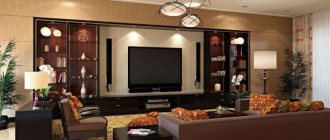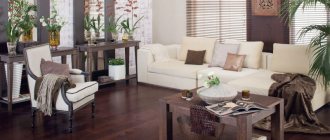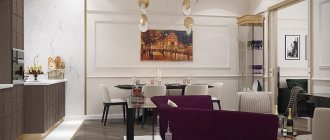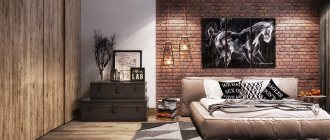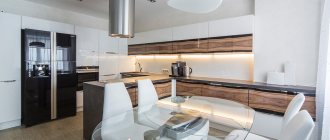The constructivist style originated in the 30s of the twentieth century. In architecture and interior design, there is an urgent need for a functional, simple and practical style direction. Designers supported this idea, in turn, adding a special aesthetic to constructivism. Today it is the most popular among style trends.
Living room-kitchen in constructivist style
The dominant feature of constructivism is its extreme rationalism in everything, no ornate ornaments, complex patterns or intricate lines. The essence of constructivism lies in the rigor of geometric shapes, the clarity of color separation and, of course, the practicality of materials.
Increasingly, active youth, striving to subordinate their lives to a certain routine, give preference to constructivism, while absolutely not depriving themselves of the right to originality. The restraint of the situation is not evidence of stinginess, either material or psychological. On the contrary, this is an indicator of the high spiritual world of the apartment owners.
Black and gray interior in constructivist style
Beige and brown living room in constructivist style
General characteristics of the style
The decor in constructivism is not just extremely restrained; it strives to absolutely avoid haphazardness and unnecessary diversity. This style served as the basis for a branch of such a style as hi-tech. Its main goal is versatility of possibilities, while maintaining the overall rigor of lines and forms, which is easily achieved with the help of effective constructivism in furniture production, as well as newfangled built-in furniture of the latest models.
Living room with fireplace in constructivist style
Living room-kitchen in a house in the constructivist style
Two-story building in constructivist style
Beige wall in the living room in the constructivist style
Spacious living room in constructivist style
Constructivism style today
Constructivism style is about spacious rooms, not overloaded with furniture, but on the contrary, reducing them to a minimum. The same applies to walls and partitions; it is preferable to use movable screens to divide the room into zones.
The colors used in constructivism are white, black, grey, metallic, red and yellow. Ornaments or stucco moldings are absolutely excluded. This style of decorating a room sometimes uses bright coatings as accents or lighting. The furniture is always simple and comfortable, has straight lines and a clear outline.
Lighting
Constructivism primarily values natural lighting. Large window openings cope well with this task. Therefore, here, panoramic windows or floor-to-ceiling windows, a large window with a door and the possibility of exiting to a terrace or balcony, will come in handy. Curtains are an absolute taboo for this style; in extreme cases, you can hang light blinds or roller blinds. When distributing artificial light, the main requirement will be its expediency.
Black and white living room in constructivist style
A chandelier, like all other lighting fixtures, should be located where they are most needed, where you cannot do without them. Lamps, chandeliers and sconces must have only the correct geometric shape, without overkill or excessive pathos.
Chandelier and spotlights in the living room-kitchen in the constructivist style
Spot lighting in the living room with a fireplace in constructivist style
Black chandeliers in the dining room in the constructivist style
Lighting above the apron in the interior of a kitchen in the constructivist style
Hallway
In the hallway there is a closet for storing things and shoes. Open shelves are excluded in it, since this will not comply with the rule of “systematization” during storage. The walls are covered with wallpaper: light in large hallways and dark in small ones. It is recommended to discard the chest of drawers as an unnecessary interior object. Instead, install a tall floor mirror with a simple frame (possibly in a bright color as an accent). If a chest of drawers is still present, then choose a wall-mounted model that will add original notes to the interior. A bench or two low stools for changing shoes are chosen in contrasting shades.
Color scheme in the style of constructivism
Typically, the color palette of constructivism is dominated by monotony. At the same time, the right to bold and bright accents is retained. The most popular options: a combination of light gray or white with black, red, dark gray, light green. As a rule, three shades can dominate; too much can deprive the interior of its integrity. Stonework or wood pattern in the constructivist style will look more like aliens; instead of the intended main background, they will become a separate bright and completely undesirable object.
Black, brown and white colors in the interior in the constructivist style
Brown-gray interior in the constructivist style White interiors in the constructivist style
White and brown interior in constructivist style
Multi-colored accents in a cozy living room in the constructivist style
Features of constructivism style in the interior
The main characteristics of constructivism in the interior are restraint of forms and functionality of premises. The style is quite strict, not tolerating “embellishments” and all sorts of excesses. All interior details should work as a single “clean” space with virtually no division into functional zones. Many people will find this direction boring. Clear rules for layout and color schemes, no soft forms or additional elements. Even decorative textiles or a vase on the table look “foreign” in this interior style. But the high-tech style, beloved by young and dynamic people, originated and absorbed the ideas of constructivism. Moreover, Scandinavian interior style also uses some similar techniques to create a harmonious space.
Decoration Materials
Constructivism will not require large financial investments from you, since the most inexpensive materials such as glass, plastic and metal are used for the interior. After all, the main goal of style is not appearance, but meeting the real needs of the customer. The aesthetic side of constructivism is quite extraordinary. Notes of elegance, however, can be traced, they are introduced by glass surfaces, chrome details, extravagant textiles, as well as bright accents. Laconism in everything is characteristic only of independent styles, such as constructivism.
Laminate and paint in the living room decoration in the constructivist style
Black walls in the living room in constructivist style
White walls in a relaxation area with a swimming pool
Multi-colored walls in the living room in constructivist style
Striped bright wallpaper in the office in the constructivist style
Furniture selection
Furniture should be comfortable and functional. It must fulfill its purpose: they eat at the table, sit on chairs, watch TV on the sofa, sleep on the bed. Use niches for shelves and install lighting there.
No ornaments or other decorative elements are allowed on the furniture. If there is a blanket on the sofa, it is not for the sake of beauty, but because of necessity.
The material for furniture can be not only wood, but also plastic and metal.
Space division
The ideal distribution of free space in constructivism excludes dividing it into rooms; it only implies zoning the room using furniture and a color palette. Well, the most characteristic aspect of this style is empty space filled with daylight, minimalism and a lot of air.
Division of space in the kitchen-dining room in the constructivist style
Brown-orange kitchen in the constructivist style Dining room in a house in the constructivist style Kitchen-dining room in the constructivist style
Studio apartment in constructivist style
Kitchen
The kitchen in the constructivist style is spacious and does not display shelves with dishes. All cabinets, appliances and fittings are hidden under panel facades painted the same color. The work surface must be empty, no parts or household appliances - a food processor or kettle is not allowed.
A rectangular sink for washing dishes, a worktop made of stone - such a kitchen will not go unnoticed. The table and chairs should have straight and clear shapes; you can install a small bar counter, but do not forget to follow the features of the constructivist style. This style is convenient because any new items for 2021 can be easily integrated into a ready-made kitchen.
Furniture and its background
In this matter, one cannot underestimate the merit of furniture and its correct arrangement, thanks to which it becomes monolithic, as if it is one with the room. Cabinet furniture seems to grow out of the walls, and tables and upholstered furniture smoothly grow into the floor. This effect is achievable through the use of clear, geometrically correct lines and shapes, and by maintaining one primary color.
A minimum of furniture in a room in the constructivist style.
In pre-war times, people treated furniture as a luxury. And for good reason, because it was decorated as best they could with all kinds of carvings and the most extravagant ornaments. The constructivists of that era offered a completely different view of pieces of furniture, discarding everything related to the aesthetic side, leaving only their direct purpose. Since production at that time was maximally overloaded, given that after the war and revolutions, many people lost their homes, not to mention the household side of the economy. Therefore, the people needed the most basic things: they needed a chair, a table and a bed. Mass production became possible only after a global change in the product itself, no stucco or decorative details. Furniture became just furniture. And it carried only a functional load. In the modern world, constructivism is easily recognizable by the countless shelves along the walls and the nakedness of the structures.
Gray and white living room in constructivist style
Brown and gray furniture in the interior in the constructivist style
White shelves in constructivist style
Black and white bathroom furniture in constructivist style
Furniture
Furniture is chosen according to the principle: the simpler the better. Each room has a sufficient functional minimum, which will be used for its intended purpose, and not stand “for beauty”. Constructivism also has its own concept of the latter. It is expressed in rationality, rigor and stylistic restraint. A kind of “adult” idea of beauty, contrasting with the “youthful” beauty of romanticism or the bright charm of Provence. In the furniture, as well as in the decoration, plastic prevails, which is offset by metal, glass and mirrors. The surfaces are smooth, without a relief texture. Upholstery of sofas and armchairs with a rough texture made from natural materials or their combination with synthetics.
The need for simple furniture, which was mass-produced in those days, arose from post-war shortages. In order for standard products to be produced quickly and cost a penny, we had to abandon all the frills. For this reason, furniture performed only basic functions: they cooked, ate, slept, sat, worked and rested on it. All other “delights” were the lot of the bourgeois layer, which was despised.
Ceiling
Modern constructivism is not very different from the style of the 20s and 30s; its main slogan still sounds like “minimalism and rigor.” But the ceiling has undergone some modifications. In those days, they could not boast of a suspended ceiling or a plasterboard ceiling, especially a multi-level one. But actually this is not surprising, because progress has not yet reached the level of constructivism of that time.
Black ceiling in the kitchen with an island in the constructivist style
Red, gray and white colors in the living room in the constructivist style
White ceiling in the living room in constructivist style
Multi-colored ceiling in the living room in the constructivist style
White ceiling in the living-dining room in constructivist style
Decoration of floors, walls, ceilings
No stucco molding or pretentious elements are acceptable in the design of walls, floors and ceilings. Everything is restrained and laconic.
Ceiling
To create a ceiling in the constructivist style, you can use stretch ceilings with a glossy surface. All coverings for the ceiling of the room must be even and smooth.
The use of a glossy ceiling in a constructivist room is stylish and appropriate
The ceiling can literally reflect the pattern of the walls. Strips of wall covering can flow organically onto the ceiling.
In rooms with high ceilings, it is appropriate to create geometric regular structures. To do this, you can use drywall painted white.
This design of the ceiling emphasizes commitment to style
Walls
An even, smooth coating on the walls is just as welcome as on the ceiling. The main color is white, but other shades are also possible - red, yellow, blue.
White color is the most applicable color in constructivism
If you want to “revive” the walls with some kind of pattern, then use the simplest shapes - rectangles, wide stripes, circles.
Paint or wallpaper are used as wall materials. The main thing is not to use a floral or patterned print (with the exception of simple geometry).
The number of walls is minimized, they are simply demolished, and to highlight certain zones, partitions are used that can be easily transported from place to place. You can even hang a photo or two on these portable elements or nail a small shelf for a houseplant.
Floor
Laminate, linoleum, carpeting are the most suitable materials for finishing floors in the constructivist style.
Linoleum laid in the kitchen is perfect for this room
Regular floor mats do not fit into the style of this design. As an option, you can lay parquet in light colors.
Who is this interior style suitable for?
In an apartment with this style, the owners will not have to rest; constructivism, on the contrary, sets up and even inspires the work process. In addition, the environment will little by little lead you to the desire for self-knowledge and the development of personal qualities and character traits.
Swimming pool in a house in the constructivist style
The next type of people for whom the constructivist style will be close are great researchers, restless experimenters or scientists. A huge advantage of this experiment is its low cost.
The style works well in rooms of any size, even the smallest. Its main advantage is its brevity and simplicity; these simple qualities will allow you to breathe life into the most cramped and shabby space, filling its image with light and comfort.
Fashionable kitchen with an island in constructivist style
White bathroom in constructivist style
Bright accents in the living room with a fireplace in constructivist style
Black and white modern kitchen in constructivist style
Distinctive features of the apartment design
Characteristic features of decorating a room in the constructivist style are the functionality of the premises and furnishings, as well as a discreet design. The object is a single space, all elements of which are interconnected and have a practical purpose. A carpet is needed to cover the cold floor; there are as many chairs as there are people in the house; The lamp is placed where they read.
The emphasis is on freeing up space. Spacious furniture is placed along the walls or hung on them, freeing up space on the floor. The room is visually expanded by installing mirrors, glossy furniture, using plain light colors to paint the walls, removing partitions and dividing the space into zones.
General principles for creating interiors apply to all parts of the room, but the design of rooms for various purposes has its own characteristics.
Factory kitchens in the style of constructivism or who was involved in the industrialization of Soviet society?
Anar GASIMOV:
The first wave of modernism, functionalism and constructivism swept through European countries and the Soviet Union more than 80 years ago. In the late 1920s, innovative architects and designers began to diversify, modify, and give original looks to plumbing fixtures, tableware, furniture, clothing, interior design, and new buildings. Many innovations that transformed boring life with the inspiration of the pioneers of constructivism are still worthy of imitation and admiration in our time.
Factory kitchens - the firstborn of Soviet constructivism
The wind of modernism and functionalism came to Soviet Russia from Germany. The Bolshevik government intensively invited German specialists to the USSR; they brought with them new ideas and developments, helped to implement them and thereby contributed to the construction of the notorious communism. Thus, with the encouragement of German colleagues, a new type of art was born in the USSR in the 20-30s of the twentieth century - constructivism.
This avant-garde movement transformed fine and decorative arts, architecture and even Soviet interiors. Citizens of the USSR began to look at life completely differently. The original appearance of many things and objects has changed. They became more strict, geometrically clear, laconic, monolithic and acquired a mass unified character.
Unusual monuments or the firstborn of Soviet constructivism can be considered Labor Palaces, Workers' Clubs, Communal Houses and Factory Kitchens. The latter deserve special attention; it was the kitchen factories that became the first result of the radical restructuring of Soviet life, which began in the post-revolutionary years.
The Bolshevik government freed Soviet women from so-called “domestic enslavement.” Female comrades were encouraged to no longer waste their time on housekeeping - cooking, laundry, washing dishes, etc.
According to the party leadership, women's labor required more efficient use; it had to be transferred from kitchens to production enterprises - factories and factories. And it was not housewives who had to feed the working class, but public catering facilities, those same factory kitchens.
They appeared in the Soviet country like mushrooms after rain, they were significantly enlarged and mechanized: they installed machines for cutting vegetables, new engineering and plumbing equipment, and dishwashing equipment.
Kitchen factories or “catering schools” were supposed to oust “philistine” home-cooked food from Soviet society, as well as restaurants, private eateries, taverns, wine bars, and the like. Moreover, the industrialization of Soviet kitchens was entrusted to German engineers.
However, specialists from Germany designed not only kitchen factories in the USSR, but also new industrial, administrative, residential and other buildings. One of these modernist architects who ended up in the USSR was Bela Shefler.
Specialists from the German company PROFACTOR Armaturen GmbH conducted their own research: they looked up archives, found old publications, historical evidence and documents that shed light on the fate of German architects - Bauhaus graduates who worked in the Soviet Union in the early 30s of the twentieth century.
A start to life
In the early 30s of the twentieth century, dozens of industrial cities arose annually in the Soviet Union. Enthusiasm was off the charts, people worked at an accelerated pace, lived in barracks, went hungry and believed in a better future. Its fantastic outlines were already visible in the drawings of modernist architects. They designed settlements in the style of constructivism, a fashionable architectural movement in the young country.
Bela Shefler was a pioneer of constructivism in the USSR; it was he who erected the building of the Museum of the History of Uralmashplant and the former Madrid Hotel in Yekaterinburg, which are considered an example of architectural constructivism of the 30s.
Bela Scheffler was a graduate of the world-famous German Higher School of Construction and Artistic Design - Bauhaus, translated from German as “house of construction”. All projects of the talented graduate breathed constructivism. The Soviet authorities liked the innovative ideas of the young specialist, and besides, he was “an insider,” as he supported and promoted Marxist ideology.
Once in Moscow, Shefler received the so-called “start in life” and was sent to Sverdlovsk, now Yekaterinburg, to the construction of the giant Uralmash plant. In the 30s, the German emigrant was in great demand and was at the peak of his career.
In Soviet Russia, Scheffler was entrusted with designing several industrial, sports and administrative facilities in the constructivist style. The young architect clearly demonstrated his knowledge, professional experience and abilities, honed in Germany. Thus was born a series of unique architectural projects, some of which have survived in Yekaterinburg to this day.
Shefler became the author of a number of pavilions specially designed for the Uralmash stadium, the Madrid Hotel, and was involved in the architectural design of the facade of the Uralmash plant management, where the administration of the enterprise is located to this day. However, the building of the Uralmash History Museum is a modernist architect. In the early 40s, Shefler was repressed and shot, his name was erased from history and forgotten for decades.
Chained by one chain
The Bauhaus school is the cradle of European architectural constructivism. This style was professed and actively put into practice by all Bauhaus teachers and graduates. They developed residential interiors, furniture, dishes, plumbing fixtures and clothing in a constructivist spirit. This was extremely fashionable in the first half of the twentieth century.
The innovative school was founded in 1919 by Walter Gropius, the developer of modernism in architecture, he was friends with the famous architect Le Corbusier. It was Gropius who attracted talented teachers to the school. Thus, the Bauhaus professor was Wassily Kandinsky, the founder of abstractionism in painting. He left Russia after the revolution and moved to Germany, where he took German citizenship. Kandinsky taught painting at the Bauhaus for several years.
In 1928, Hannes Meyer was appointed the new director of the Bauhaus, and Bela Scheffler became his favorite student. Meyer and Scheffler were united not only by professional interest, science, creativity, but also by communist ideas. Moreover, Marxist ideology was actively discussed within the walls of the Bauhaus.
Liberal views reigned at the school, many teachers and students openly sympathized with the communists, participated in rallies, protested, and condemned the growing fascists. The latter, naturally, immediately disliked the Bauhaus. They called the architectural school a “breeding ground for communism,” and they were right! Some of Meyer's students were professional revolutionaries, including Bela Scheffler.
Feel comfortable
Bela was born in Minsk into a Jewish working-class family; his father was an engineer. In 1904, the entire Scheffler family moved from Belarus to Germany. In Hamburg, the young man graduated from high school, then from the school of arts and crafts and became a certified carpenter. This peaceful craft guaranteed a stable and comfortable life, if not for the political trends coming from Soviet Russia.
Many artisans and workers in Germany listened to Bolshevik propaganda; they naively believed that communism had won in the USSR, and people there lived happily. Daredevils from Europe and America went to Russia for a better life and disappeared without a trace.
Not knowing what was really happening in the Soviet Union, German citizens united under Marxist slogans, and the German Communist Party gained strength. Shefler was carried away by this funnel, he came under Bolshevik influence and began an active political life.
In 1922, Scheffler joined a German youth organization copying the Komsomol - the Komsomol. Being an active Komsomol member, Scheffler began to fight on the barricades of Hamburg under the leadership of Ernst Thälmann. However, the young man quickly played out the game, he was arrested and sent to prison. Shefler was lucky; his imprisonment was short-lived; six months later he was granted amnesty.
Apparently, Scheffler’s revolutionary fervor cooled down in prison; he had enough time to think about his future, and after the amnesty he began to improve his education. Scheffler learned that one of the indispensable conditions for admission to the Bauhaus school was mastery of a craft. This condition was beneficial to the professional carpenter! He prepared and immediately entered the construction department of the Bauhaus.
Having become close to the Bauhaus teachers and students, Scheffler felt “at ease.” He was surrounded by talented people who shared Marxist ideas. And the school director, Hannes Meyer, openly preached communist views, which caused him to incur the wrath of the National Socialist authorities. In such a situation, Scheffler's revolutionary fervor awoke again, he became friends with the school director, and in 1928 he joined the ranks of the German Communist Party.
Escape to the USSR
In 1930, Scheffler completed his studies at the Bauhaus. According to archival information obtained by PROFACTOR Armaturen GmbH, the graduate was entrusted with the first major project - the Laubengang housing complex, which was intended for working families. Scheffler approached the work on a grand scale; he introduced innovative solutions into the residential complex and designed it in a constructivist style.
Laubengang consisted of 5 four-story building blocks, each of which had 18 apartments. They were distinguished by increased comfort and were quite affordable at prices. The residential complex was erected quickly and people began to move in. However, Scheffler was not destined to see his brainchild, not to mention receiving thanks and awards.
The Nazis came to power and immediately the communist architect of Jewish origin found himself in disgrace, he was removed from work and advised to leave Germany as quickly as possible. At the same time, the Nazis fired Hannes Meyer. In order not to be repressed and to continue his professional activities, the former director of the Bauhaus decided to move to the Soviet Union and invited Bel Shefler with him.
In February 1931, Meyer and Scheffler said goodbye to Nazi Germany and went to the USSR together, joined by several other Bauhaus graduates. Two years later, in 1933, the National Socialists completely abolished the Bauhaus school. The entire teaching staff and students were forced to leave Germany, they dispersed all over the world.
PROFACTOR Armaturen GmbH specialists learned that Bauhaus architects erected buildings in the constructivist style in Western Europe, America and Asia. Their unique works were included in textbooks on urban planning, and numerous articles and monographs were written about them. However, almost nothing was known about those who worked in the Soviet Union. Although, the largest group of German students and teachers from the Bauhaus came to the USSR - 23 people.
Renunciation of German citizenship and consequences
Moscow was already waiting and preparing for the arrival of a group of architects from Germany. The Germans were received very cordially, immediately surrounded with increased attention, created working conditions and appointed to prestigious positions. Bela Shefler became an associate professor at the All-Union Institute of Architecture and Construction (VASI), he was fluent in Russian and therefore easily delved into the work. Soviet citizens fascinated the German emigrant; they were especially captivated by their enthusiasm, patriotism and desire to selflessly work for the benefit of the Soviet country and the Communist Party.
Party leaders “processed” Shefler in every possible way, and in order to make sure of his loyalty to the Soviet system, they offered to give up his German passport and become a citizen of the USSR. With his Jewish origin, Scheffler did not see a future in Nazi Germany; he accepted Soviet citizenship and thereby “burned all the bridges” to retreat. Moreover, in 1931, Scheffler joined the ranks of the All-Union Communist Party (Bolsheviks) and became a member of the trade union.
A newly made citizen of the USSR and member of the All-Union Communist Party of Belarus, Bel Shefler, is sent to Sverdlovsk, now Yekaterinburg, to the construction of the giant Uralmash plant. For several years, the Bauhaus graduate worked on the design of important objects, but the Stalinist machine of repression had already been launched, and Scheffler fell under its millstones.
The fate of the young architect in Sverdlovsk will be tragic - he will be expelled from the party, fired from his job and arrested along with his family as an “enemy of the people.” In 1942, when the fascist army reached Moscow, Scheffler was recognized as an agent of German intelligence and sentenced to capital punishment.
Bel Shefler was posthumously rehabilitated in 1989, but the name of the pioneer of constructivism, alas, is still in oblivion. If there is no trace left of kitchen factories in modern Russia, then Scheffler’s favorite brainchildren – the Museum of the History of the Uralmash Plant and the former Madrid Hotel – are in perfect order. They became a kind of monument to the Bauhaus graduates who moved from Germany to the USSR and made a huge contribution to the development of Soviet Russia.
Text - Gustav REISCH, technical specialist at the German company Profactor Armaturen GmbH
Photos and illustrations from the Internet
Dedicated to Olga K.
